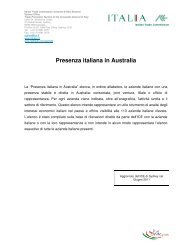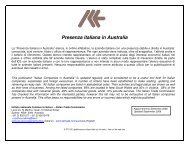Price Determination in the Australian Food Industry A Report
Price Determination in the Australian Food Industry A Report
Price Determination in the Australian Food Industry A Report
Create successful ePaper yourself
Turn your PDF publications into a flip-book with our unique Google optimized e-Paper software.
Figure 79. Flour, 1kg, supply cha<strong>in</strong> map<br />
Farmer<br />
Primary Process<strong>in</strong>g Market Logistics Retail<br />
Brand Ownership/Management<br />
Farmer<br />
harvest/<br />
transport/store<br />
Miller*<br />
Packer*<br />
Consumer<br />
<strong>Food</strong>s<br />
Marketer*<br />
Wholesalers<br />
Export Markets<br />
(bulk only)<br />
Cha<strong>in</strong> Retailers<br />
<strong>Food</strong> Service<br />
Consumer<br />
• 20+ million tonnes of wheat produced.<br />
• Australia-wide production but traditional<br />
mill<strong>in</strong>g wheats focused <strong>in</strong><br />
Queensland/nor<strong>the</strong>rn New South Wales.<br />
• <strong>Price</strong> drivers <strong>in</strong>clude net returns from<br />
world market.<br />
• Large number of players but <strong>Australian</strong><br />
Wheat Board still dom<strong>in</strong>ates supply of<br />
wheat to millers. This may change with<br />
Allied purchase of Goodman Fielder<br />
mills.<br />
*can be <strong>in</strong>tegrated or separate players<br />
• 65% of total wheat produced is<br />
exported, but only 15% of flour produced<br />
is exported.<br />
• Four mills produc<strong>in</strong>g retail flour with<br />
considerable excess capacity (10 mill<strong>in</strong>g<br />
companies of which three have total of<br />
84% of capacity).<br />
• Domestic mill<strong>in</strong>g <strong>in</strong>dustry uses only 2<br />
million tonnes of wheat produced.<br />
• Little value-add<strong>in</strong>g activity.<br />
• Most flour sold <strong>in</strong> bulk.<br />
• 1.25 tonnes wheat produces 1 tonne<br />
flour.<br />
• By-product recovery prices a key factor<br />
<strong>in</strong> profitability.<br />
O<strong>the</strong>r Retailers<br />
• Little sale of 1 kg packet<br />
flour <strong>in</strong>to food service – 1kg<br />
is a specialty retail item.<br />
• Supermarkets account for<br />
95% of sales.<br />
• Branded product about<br />
50%.<br />
FLOUR – ANALYSIS OF PRICING<br />
The <strong>Australian</strong> retail market<br />
<strong>Price</strong> <strong>Determ<strong>in</strong>ation</strong> <strong>in</strong> <strong>the</strong> <strong>Australian</strong> <strong>Food</strong> <strong>Industry</strong> A <strong>Report</strong><br />
Flour is <strong>the</strong> key product l<strong>in</strong>e for <strong>the</strong> <strong>Australian</strong> wheat <strong>in</strong>dustry <strong>in</strong> terms of domestic process<strong>in</strong>g.<br />
However, <strong>the</strong> packet flour market is only a small component of overall flour usage.<br />
Packet flour accounts for only 5 per cent of flour manufactur<strong>in</strong>g. As such, <strong>the</strong> packet flour market<br />
has a relatively small <strong>in</strong>fluence on overall miller profitability and trends through <strong>the</strong> cha<strong>in</strong>. About<br />
95 per cent of packet flour sales are through <strong>the</strong> supermarket channel. Private label represents<br />
about 30 per cent by value but almost 50 per cent by volume.<br />
The graph below shows <strong>the</strong> difference <strong>in</strong> pric<strong>in</strong>g between private label and <strong>the</strong> range of branded<br />
product.<br />
Figure 80. Retail price of flour by label, 1kg pack, $/kg<br />
$<br />
2.50<br />
2.00<br />
1.50<br />
1.00<br />
0.50<br />
0<br />
private commodity premium<br />
label brand brand<br />
Source: <strong>Industry</strong> sources<br />
76







